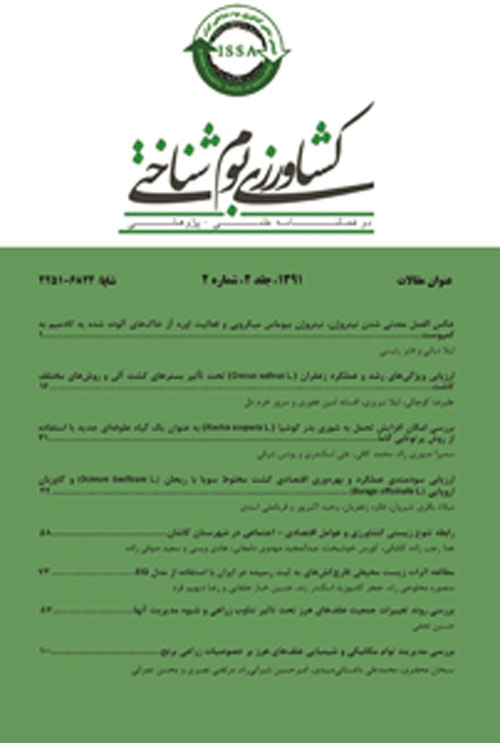Analyzing soybean yield constraints in Gorgan and Aliabad katul using CPA method
Author(s):
Abstract:
Introduction
Removing the yield gap (the difference between farmed yield and potential yield) is known as the most important way to increase crop production (Egli and Hatfield, 2014). Therefore, the amount of yield gap and the reasons for it are important. Soybeans [Glycine max (L.) Merrill] are one of the most important oilseed crops in the world (FAOSTAT, 2016). In Iran, the area of soybean cultivation is up to 66,000 hectares and annual production is 151,000 tons (Ministry of Agriculture Jihad, 2013). This does not meet domestic requirements, however, so soybean production should be increased. For this purpose, a field study was conducted in 138 farms using an application of regression modeling in 2013-15 in cities of Gorgan and Aliabad Katul.Materials And Methods
Farms were selected with the help of agricultural service centers. Based on information provided by the service centers, farms were selected based on their diversity in terms of area under cultivation, management and yield. Management factors included a history of production, planting methods, inoculated or non-inoculated seed with bacteria, seed rate, nitrogen fertilizer (N) rate, phosphorus fertilizer (P2O5) rate, potash fertilizer rate, the number of plowings, planting date, cultivar type, previous crop, use or non-use of N fertilizer top-dressing, number of N fertilizer top-dressing, use or non-use of herbicides, use or non-use of pesticides, animal manure type, irrigation type and amount, harvest methods, and others (a total of 67 management factors). All information about management operations were recorded and measured. Then, the relationship between actual yield and the 67 management variables were assessed using stepwise regression.Results And Discussion
The average yield for farms was 2,908 kg per hectare and the maximum yield was 5,100 kg per hectare. Model Root Mean Square Error (RMSE) was 274 kg per hectare and coefficient of variation (CV) was 9 percent. These statistics showed that the accuracy of the model was acceptable. Therefore, the model could be used to determine the yield gap and the share of yield constraints. Model yield, on average, was estimated at 2,918 kg per hectare and maximum yield was 4,820 kg per hectare. In this model, total yield gap has been estimated at 1,902 kg per hectare. Accordingly, the most important factors in yield gap for the region included: number of irrigations with 29% (equivalent to 535 kg per hectare), net nitrogen with 22% (equivalent to 419 kg per hectare), P2O5 with 20% (equivalent to 365 kg per hectare), planting date with 16% (equivalent to 302 kg per hectare) and disk number with 13% (equivalent to 250 kg per hectare).Conclusion
With optimized items listed, soybean yield could be increased approximately 1,871 kg per hectare in Gorgan and Aliabad Katul. Use of this method isnt suitable for determining optimum values. In order to determine optimum values for each listed item, other methods can be used for yield gap analysis, such as a boundary line analysis.Keywords:
Language:
Persian
Published:
Journal of Agroecology, Volume:7 Issue: 1, 2017
Page:
109
magiran.com/p1733925
دانلود و مطالعه متن این مقاله با یکی از روشهای زیر امکان پذیر است:
اشتراک شخصی
با عضویت و پرداخت آنلاین حق اشتراک یکساله به مبلغ 1,390,000ريال میتوانید 70 عنوان مطلب دانلود کنید!
اشتراک سازمانی
به کتابخانه دانشگاه یا محل کار خود پیشنهاد کنید تا اشتراک سازمانی این پایگاه را برای دسترسی نامحدود همه کاربران به متن مطالب تهیه نمایند!
توجه!
- حق عضویت دریافتی صرف حمایت از نشریات عضو و نگهداری، تکمیل و توسعه مگیران میشود.
- پرداخت حق اشتراک و دانلود مقالات اجازه بازنشر آن در سایر رسانههای چاپی و دیجیتال را به کاربر نمیدهد.
In order to view content subscription is required
Personal subscription
Subscribe magiran.com for 70 € euros via PayPal and download 70 articles during a year.
Organization subscription
Please contact us to subscribe your university or library for unlimited access!



